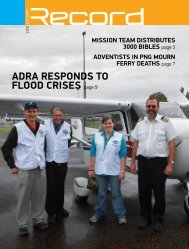Download Adventist World as a PDF - Record
Download Adventist World as a PDF - Record
Download Adventist World as a PDF - Record
Create successful ePaper yourself
Turn your PDF publications into a flip-book with our unique Google optimized e-Paper software.
SPECIAL FEATURECancerBy Allan R. Handysides<strong>World</strong>wideWhat’s the story in your region?Cancer is a major globaldise<strong>as</strong>e. It’s estimated thatabout 13 million new c<strong>as</strong>esand 7.6 million deaths from canceroccurred in 2008. This is an incre<strong>as</strong>efrom 2003, when the <strong>World</strong> HealthOrganization’s <strong>World</strong> Cancer Reportnoted about 10 million new c<strong>as</strong>esand some 6 million deaths. 1No region of the world is cancerfree.Age-standardized cancer ratesallow identification of particular geographicvariations, but not all datab<strong>as</strong>esare of the same quality. Generalizations,however, can usually be madewith some degree of reliability.Regional differences in cancer ratesare very distinct. The United Statesrates high, with some 334 c<strong>as</strong>es ofcancer per 100,000 men. Australia andNew Zealand, with 356.8 per 100,000,h<strong>as</strong> worse statistics. Northern Europeat 303.5 and Western Europe at 337.4per 100,000 also have high rates. Therisk of dying from cancer is evenhigher in Central and E<strong>as</strong>tern Europe.Women in the same regions also havehigh rates of cancer, particularlybre<strong>as</strong>t cancer.The lowest cancer rates occur inCentral and West Africa, and South-Central Asia for men and Central andNorth Africa for women. 2Affluent societies carry a higherburden of cancer, usually related totobacco smoking and other factors<strong>as</strong>sociated with a Western lifestyle.In developing countries, 25 percentof tumors are <strong>as</strong>sociated with chronicinfections such <strong>as</strong> hepatitis B (livercancer), human papilloma viruses(cervical cancer), and Helicobacterpylori (stomach cancer).In some Western countries thereh<strong>as</strong> been a decline in cancer mortalityrates, because fewer people are smoking.<strong>World</strong>wide, lung cancer is themost common, followed by bre<strong>as</strong>tcancer and then colon cancer.Cancer deaths are most oftenrelated to lung, stomach, and livercancer. The incre<strong>as</strong>e in the world’spopulation is responsible for some ofthe gross incre<strong>as</strong>e in cancer statistics.Because some cancers are moreamenable to treatment, cancer ofbre<strong>as</strong>t, prostate, and uterine/cervix,for example, are the cause of death inonly a minority of patients so affected.Causes of CancerMany factors impact the prevalenceof human cancer. These rangefrom cancer-inducing agents, or carcinogens,to chronic infections,dietary and lifestyle factors, alcoholconsumption, and genetic susceptibility.Some 20 percent of cancers are<strong>as</strong>sociated with chronic infections.The most hazardous human carcinogensinclude tobacco, <strong>as</strong>bestos,aflatoxins, and ultraviolet light.TobaccoTobacco smoke is irrefutably causally<strong>as</strong>sociated with lung cancer. Lessrecognized is the <strong>as</strong>sociation oftobacco with laryngeal, pancreatic,kidney, bladder, and—in conjunctionwith alcohol—oral and esophagealcancer.The age a person begins to smokeaffects incidence of cancer. Adultsaged 55 to 64 who smoke 21 to 39 cigarettesper day and commencedsmoking before age 15 are three timesmore at risk to die of lung cancer thanthose who started after age 25.Certain varieties of tobacco (e.g.,black tobacco) may be more dangerousthan others, but there is no safetobacco. 3AlcoholThe <strong>World</strong> Cancer Report 2003listed alcohol <strong>as</strong> second in its summaryof cancer causes. Heavy alcoholconsumption causes cancer of theoral cavity, pharynx, larynx, esophagus,and liver, and incre<strong>as</strong>es the riskof bre<strong>as</strong>t and colorectal cancer. Acausal relationship between alcoholand colon and rectal cancer is alsostrongly suggested, and the risk ofhead and neck cancers in heavydrinkers is some five to 10 timeshigher than in nondrinkers.The risk correlates to the amountof alcohol consumed. Changing pat-December 2012 | <strong>Adventist</strong> <strong>World</strong> 11
















